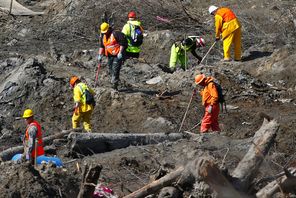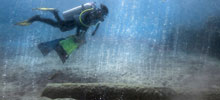Originally published Tuesday, April 1, 2014 at 9:26 PM
Spring runoff a threat to those downriver of Oso mudslide
Even as searchers continue to recover the remains of victims from the muck of the deadly Snohomish County mudslide, officials warned Tuesday the effort could be threatened by spring flooding.
Seattle Times staff reporters
![]()
Searchers on Tuesday continued to recover the remains of victims from the muck of the deadly Snohomish County mudslide, but an official warned Tuesday the effort could be threatened by spring flooding.
Slide debris blocking the North Fork of the Stillaguamish River could divert the increased flows from snow runoff into a new channel along the route of state Highway 530, potentially threatening homes downstream, according to an operations official with a state incident-command team.
“There is a high probability that the river could end up flowing down what was the highway,” said Mike Asher, operations section chief for the state incident-command team in charge of the response effort.
To prevent the river from taking that course, state officials have asked the Army Corps of Engineers to come up with a plan to create an alternative channel that could safely handle the peak spring flows.
“They are the professionals,” Asher said Tuesday. “They have the ability to build berms and dikes; whatever it takes to control the direction of the floodwaters.”
Asher said he is hopeful that the Corps can come up with a plan within the next few days.
The March 22 mudslide slammed down from a slope on the north side of the river and barreled across the channel, leaving behind massive amounts of debris.
Some water is flowing around the debris.
But a lot of it remains pooled up behind debris at depths that are some 25 feet above normal river levels. Searchers believe human remains are located in some of these areas, but it’s too dangerous to search until some sort of channel is created to improve flows, Asher said.
The risks will rise during spring runoff, which is expected to increase flows fourfold as warmer temperatures melt a heavy snowpack that blankets surrounding slopes.
The high water is expected to pile up even more debris, which officials fear could divert the river into a channel along the slide-ravaged Highway 530 and threaten downstream property.
On Tuesday, the Snohomish County Medical Examiner’s Office said the death toll for the Oso-area mudslide had climbed to 28, an increase from the 24 reported Monday.
The number of missing has dropped to 20.
The number of victims is expected to increase Wednesday during the twice-daily updates provided by the Medical Examiner’s Office. Search officials confirmed they had recovered additional remains during Tuesday’s search.
In addition to the unmeasurable and mounting toll in lives, the cost of damage and cleanup from the Snohomish County mudslide is expected to exceed $42 million.
As the governor’s office asked President Obama to declare the slide a “major disaster,” paving the way for federal aid for victims, it estimated the cost of debris removal at $22 million and the cost of search and recovery operations at more than $10 million.
That amount does not include the nearly $10 million in direct losses, including $3.4 million for lost personal property, cited in Gov. Jay Inslee’s Monday letter seeking the declaration to secure federal aid to individual victims who survived the mudslide or lost their homes in it.
The estimates do not include the cost of repairing Highway 530.
Obama has already approved an expanded emergency declaration, allowing for federal help and reimbursement on rescue operations. But only a declaration of major disaster would make direct federal aid available for affected families.
Just how long the recovery operation might last was a question Bellevue Fire Department Lt. Richard Burke struggled to answer.
“I think the community, the governor, the real experts are evaluating this every day,” he said while leading reporters on a tour of the site near the Arlington side Tuesday. “Our goal is closure for the community of Oso. We’ll have to come to that decision somewhere down the road as a community.”
Standing water continued to recede Tuesday as the rains that had bogged down the search effort early on kept easing. “We’ve got fewer folks controlling the water and more with their hands on the ground. And that’s really what we need,” Burke said.
Volunteer rescue workers — many family members of the victims — had been replaced by professional-search teams from area fire departments and the Washington National Guard.
“This afternoon, we transitioned out most of the volunteers,” Burke said. “They gotta get back to their lives. Back to work. They’ve allowed us to step into their shoes for a couple of days.”
But in Darrington, some 25 volunteers continued work on the east side of the slide, according to an official. Asher, speaking from Darrington, said the state still needs more search assistance from the Federal Emergency Management Agency.
Search teams are using a long-arm excavator to help probe mud that reaches depths of up to 70 feet. Another excavator on the way will be mounted on pontoons to help probe watery areas, said Steve Harris, division supervisor for the east portion of the search, based in Darrington.
A boat motoring in flooded areas is equipped with U.S. Geological Survey side-scan sonar that can scan the muck, generating images that could help searchers spot outlines of human remains, Harris said during a media briefing.
“We are trying to use every type of tool that we can find and think of,” said Harris.
But Harris cautioned that “there is a potential” that some remains will not be found.
State and federal geologists installed several instruments Tuesday to better monitor the stability of the slope.
The U.S. Geological Survey used a helicopter to place three instrument packages — called “spiders” because of their metal legs — on the flanks of the slide area and on the plateau above, said Tom Badger, geotechnical engineer for the Washington Department of Transportation.
Each spider contains GPS sensors and seismometers, to help detect any motion that might precede another slide.
Badger and his team also installed instruments called extensometers above the slide. The devices include fixed stakes attached to sensors by long cables. “If the ground starts to move, it pulls the cable and the instrument measures how much it pulls the cable,” Badger said, speaking by cellphone from the site.
Several other methods, including traditional surveying and laser scanning, are also being used to watch for creeping or cracking.
The goal is to ensure the safety of the hundreds of searchers, Badger said.
Catholic Community Services of Western Washington has announced that it will cover the costs of burial services for victims of the mudslide, regardless of their religious affiliation, said the Rev. Tim Sauer, pastor at St. John Vianney Church of Darrington and Immaculate Conception Church of Arlington. Part of the Seattle Archdiocese, Catholic Community Services is accepting donations from across the country.
“It’s a reflection of what people are truly like. When things are at their worst, people are at their best,” Sauer said Tuesday.
Hal Bernton reported from Darrington, and Lornet Turnbull reported from Arlington. Information from Seattle Times staff reporters Kyung M. Song, Sandi Doughton, Brian M. Rosenthal and Jennifer Sullivan also is included in this report.
 Four weeks for 99 cents of unlimited digital access to The Seattle Times. Try it now!
Four weeks for 99 cents of unlimited digital access to The Seattle Times. Try it now!













